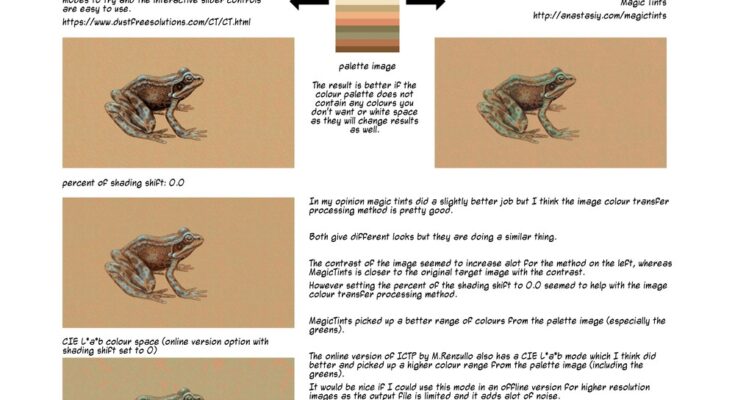Over the weekend I went down another rabbit hole of sorts finding out about an open source tool called Image Colour Transfer Processing by M RenzuIIo and T Johnson. There is a very informative Medium article they wrote here if you would like to learn more.
Since it immediately reminded me of another tool I have used called MagicTints I decided to do some tests. I also tested a filter in G’MIC called Transfer Color (PCA). I am aware that the current version of Photoshop has similar functions with its neural style filters but as I’ve said before I don’t use Photoshop so I can’t compare them here. Someone with a copy of Photoshop is of course free to do so.
Here are my tests.

Text from this image is as follows with a few additions for this article:
I tested these images with the Image Colour Transfer Processing executable version which uses lαβ colours.
The web version of this gives some additional modes to try and the interactive slider controls are easy to use. I also tested the CIE L*a*b mode which is only available in the online version at the time of writing this article. The authors article goes into the technicalities behind this in detail if you are interested.
I also tested MagicTints and I tested the Transfer Color (PCA) filter in G’MIC (I used the version of G’MIC that comes with Fell because I find it useful when working with layers and images).
When using a palette image the result is better if the colour palette does not contain any colours you don’t want or white space as they will change results as well. The Image Colour Transfer online method does also say that it is better to use a small image for the palette image otherwise it will add processing time.
In my opinion magic tints did a slightly better job but I think the image colour transfer processing method is pretty good.
Both give different looks but they are doing a similar thing. It could be a subjective choice depending on which someone would prefer to use.
I do appreciate there are more controls to tweak in the image colour transfer processing method as someone who likes to have creative control, but the one click approach of MagicTints is very convenient. You also get the ability to export a LUT from MagicTints which can then be used in other software that supports this functionality.
The contrast of the image seemed to increase a lot for Image Colour Transfer Processing, whereas MagicTints is closer to the original target image with the contrast.
However setting the percent of the shading shift to 0.0 seemed to help with the image colour transfer processing method. That was the only slider value I changed for this test.
MagicTints picked up a better range of colours from the palette image (especially the greens).
The online version of the image colour transfer processing by M.RenzuIIo is an implementation of the Enhanced Image Colour Transfer methods developed by T. E. Johnson, with an additional choice of lαβ and CIE L*a*b colour space. which I think did better and picked up a higher colour range from the palette image (including the greens).
It would be nice if I could use CIE L*a*b colour space in an offline version for higher resolution images as the output file from the online version is limited in size when saving it and it adds alot of noise.
G’MIC has a filter called Transfer Color (PCA) which acts like these other tools (I think). The contrast is quite high but it might be a nice look as well depending on what you want. Further image editing could solve that issue anyway.
If you have a LUT file G’MIC can be used to apply it to an image using the Apply External CLUT filter. From doing these tests using G’MIC I also came across some other useful filters such as the Color Presets and the Color Grading filters which are cool to play with.
Thanks for reading.
Please help support my blog
Liberapay .
Buy me a coffee .
Kofi .
Payhip .
Gumroad .
PayPal
Source link



